Imitation of brickwork is a fashionable design technique. This texture looks very picturesque, perfectly zoning the room, and if painted in light colors, visually expands the room. Real masonry significantly reduces the size of the room, therefore, a do-it-yourself brick wall made of plaster, foam, tiles is more popular.
Advantages of a brick wall
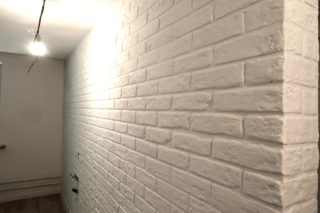
An ordinary flat surface gives the impression of being solid. The masonry is formed by a sequential alternation of clear rectangular elements. The length of the brick is noticeably greater than the height, such a horizontal structure expands the room. However, the effect cannot be abused: 3 brick walls no longer affect visual perception.
Imitation brickwork has many advantages:
- The orderly alternation of details creates an expressive, beautiful texture. Such an element of the interior always attracts attention.
- A brick wall allows you to zone a room or studio apartment.
- Imitation can be used in the interior to visually change the configuration of the room. A solid wall expands the room, a narrow fragment or several - raise the ceiling. Finishing the corners makes them stand out, emphasizing the configuration.
- Tiles, polystyrene, wallpaper allow you to reproduce any type and color of masonry. In a Provence style apartment, imitation in light colors is used. Red brick is interesting in the English style, country, techno and loft. Deliberately old or dark stone is an excellent solution for a loft or industrial home.
- Any imitation takes up much less space than real brickwork.
- Plastering or wallpapering takes much less time than brickwork and costs less.
- The trim can always be removed or replaced.
- Most materials do not conduct heat well, so the imitation stays warm to the touch. A real brick partition is very cold; more energy is required to heat a room in winter.
The decorative element is not applicable for classic styles.
Preparing the wall before work
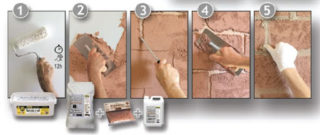
Brick finish is a decorative solution. In order for the imitation of masonry to be beautiful, it is necessary to prepare the surface. The work depends to some extent on the chosen decoding method:
- Remove old finishes: plaster, wallpaper, tiles.
- The brick surface should be as flat as possible. The wall is primed and plastered, carefully leveled, filling up cracks and rusty. No putty needed.
- If the imitation involves fixing tiles, plastic, sawn bricks, it is re-primed: this way the ability to set is increased.
- If the walls are covered with wallpaper, no primer is needed, but a putty may be needed.
It is impossible to start such repairs in a new house: the walls of a newly built building shrink. You must wait at least 1 year.
The smoothest surface is obtained by finishing the wall with sheets of drywall. The cost of work changes little.
Making a brick wall from plaster
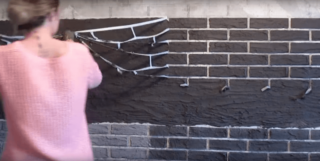
A brick wall with your own hands made of plaster is a rather laborious option, but very practical.On the one hand, this imitation looks more realistic than wallpaper. On the other hand, unlike clinker or tiles, plaster "masonry" does not burden the walls, it is vapor permeable enough and retains heat well.
Finishing production consists of 3 stages: marking, masonry formation and adjustment. The most difficult stage is marking. In stores, you can find a ready-made mesh, which is applied to the surface. The step-by-step instructions contain a detailed description of the finish. If it was not possible to buy one, the markup is performed with improvised means.
- A brick pattern is cut out of cardboard. On average, its length is 25 cm, and its height is 7 cm. 1.5 cm are taken away for the seams. The template is cut out with seams. Designate the center of the brick in the drawing, taking into account the seams.
- Installation is started from the lower left corner. At least 5 cm recede from the floor and ceiling. The template is applied in the wall, the contours are drawn and the center is marked. First, the wall is drawn like a grid, and then through a row the "brick" is divided in half, in the center. This is how the standard brick "masonry" is obtained.
- The marked lines are glued with masking tape 15 mm thick. Be sure to leave free ends so that it is easier to remove the tape later.
- Make a plaster mortar. Most often, a mixture of gypsum plaster and tile adhesive is used. If the wall is made in the bathroom, use a special plaster mixture. The solution is kneaded by hand or using a construction drill or mixer.
- The plaster slowly but hardens, so it is prepared in portions.
- The mixture is applied to the wall with a spatula, carefully leveled up with a wide spatula.
- As soon as the mixture has set, but not until it hardens completely, remove the tape. It turns out "masonry".
- After hardening, the "bricks" are processed with fine-grained emery paper, the sharp edges are rounded off. To achieve a good imitation, small chips and scratches are made.
The plaster's own color is not very attractive. Usually "brickwork" is primed and then painted. You can paint the entire wall, you can only paint "bricks" or paint in 2 different colors "bricks" and "seams".
The paint is selected in accordance with the purpose of the room. It is better to take a water-based one, so that in the future the decor can be washed.
Imitation of brick on the wall with foam plastic
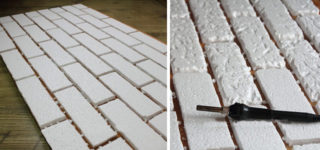
To make bricks of different shapes on the wall without using building stone, you can use regular styrofoam. The material is very light, retains heat, and the cost of finishing is minimal. Styrofoam can be cut, painted, bent. This finish is not very durable and can be scratched or crumpled.
It is recommended to purchase fine grain high density foam for finishing. This material does not crumble during cutting.
- The markup is performed in 2 ways. The first is similar to the one described above: a template is made from cardboard or foam, and then the required number of elements is cut out of the material. Fastening each part will take a long time, but such an imitation looks more believable. You can do it easier: they draw a sheet of foam plastic and burn the seams in it with a soldering iron. Plastic deforms easily when heated, so that the seams are neat with rounded corners.
- Bricks are laid from the corner, window and door openings are closed up last. Each element or a whole sheet is glued to liquid nails. The sheet can be fixed with self-tapping screws.
- To make the "masonry" more similar to the real one, the foam is treated with a thin layer of plaster. This gives an uneven texture. Painting or varnishing is possible.
When working with a soldering iron, you must use a protective mask. When melted, the foam evaporates harmful substances.
DIY brick wall from tiles
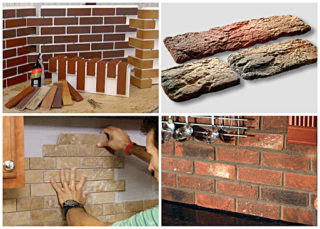
In the construction hypermarket, you can find ready-made options. It is very easy to create a brick wall with your own hands using tiles. They produce ceramic and elastic ones based on polyacrylic.The second option is simpler and easier, since polymer tiles weigh less and are cheaper.
The main advantage of flexible clinker is the ability to stick on uneven, difficult surfaces. This "brick" bends around even sharp corners. The material is intended for interior decoration, however, it is resistant to cold, not afraid of the sun and tolerates rather high humidity.
- Preparing the wall for finishing with flexible tiles begins with marking. Use a regular pencil and ruler to trace the surface. It's not necessary to make a template here
- Cut the sheets of material to size.
- Tile or special glue is applied to the wall with a notched trowel. Layer thickness not less than 3 mm. It is not necessary to immediately apply glue to the entire surface: it sets quickly.
- The tile is applied to the wall, pressed and smoothed.
- After installing the "masonry", the seams are leveled with a thin brush dipped in water. Grout is not needed here.
Instead of elastic cladding, you can use hard tiles - gypsum, cement. They are cheaper, they imitate the texture of the stone well. However, the plaster finish is afraid of water, so it cannot be used in the bathroom and in the kitchen.
Working with hard tiles or artificial bricks is more difficult. You can cut the material only with the help of special tools: a circular saw or a grinder with a disc. The seams between the elements must be rubbed in order to give the masonry a neat look and prevent water from entering the joints.
Imitation of masonry wallpaper

The simplest option is pasting with wallpaper imitating brickwork. Such decoration attracts with its diversity: different shapes and sizes of bricks, any color scheme, additions in the form of green plants, drawings, inscriptions.
Gluing wallpaper is easy. The canvases are coated with glue, layers of glue are applied to the wall, if we are talking about thick vinyl wallpaper, and the fragment is glued to the wall. The canvas is gently smoothed and pressed to expel air bubbles.
Select material for decorativeness and taking into account the characteristics of the room. For the living room, you can take simple paper and expensive silk wallpapers. The kitchen needs waterproof vinyl. To make the "brickwork" look more voluminous, choose thick embossed wallpaper.
Required tools and fixtures
Tools for the job:
- a pencil and a ruler are needed for marking; scissors are required for cutting the material;
- to knead the plaster mixture, it is better to use a construction mixer;
- for finishing from plaster, masking tape is required, 15 mm wide, you can use a wider one;
- spatulas are needed - for applying plaster or glue;
- you will also need paint or varnish to give the brick wall aesthetics.
Special tools are needed to work with hard tiles or clinker.
Useful Tips
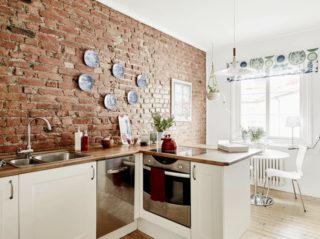
When choosing a decor, you should take into account the style features, the purpose of the room and the interior:
- In the living room, a brick wall or a fragment of it is most common. The texture of the masonry is able to revive the most ordinary room. The finishes go well with modern and classic furnishings. However, this option should not be combined with wallpaper, especially with a floral pattern. It is best to plaster and paint the rest of the walls in one color.
- In the bedroom, imitation masonry is often used for zoning. "Masonry" is successfully combined with oversized wardrobes;
- In the bathroom, "masonry" visually expands the space. It is better to combine it with a stone surface. Ceramic trim nearby, unless it reproduces stone, is excluded. The color is selected based on the style. Usually, light colors are preferred in the bathroom in order to visually make the room more spacious and lighter, but with a large area, a piece of dark chocolate masonry will bring an exotic touch to the interior.
- In the kitchen, a brick wall creates a cozy atmosphere, perfectly matches the kitchen utensils and the most modern equipment.An imitation of a stove or hearth is often combined with masonry in order to emphasize the purpose of the kitchen. However, such a finish does not match a modern or high-tech colored kitchen set. Simple shapes and sufficient “modest” color are required here.
- In the hallway, corners are most often covered with bricks. The decoration visually distinguishes them against the uniform background of other walls and creates the impression of a larger space. Here, the masonry should act as a vertical element, therefore it very rarely occupies the entire wall.
It is not necessary to close up a long corridor with a "brick": it gives the impression of a prison casemate.
A brick wall as an interior element is especially popular in a studio apartment. Thus, it is easy to separate the living room area from the bedroom, the dining room from the kitchen or the nursery, however, such decoration performs its function if it is not obstructed by furniture.








